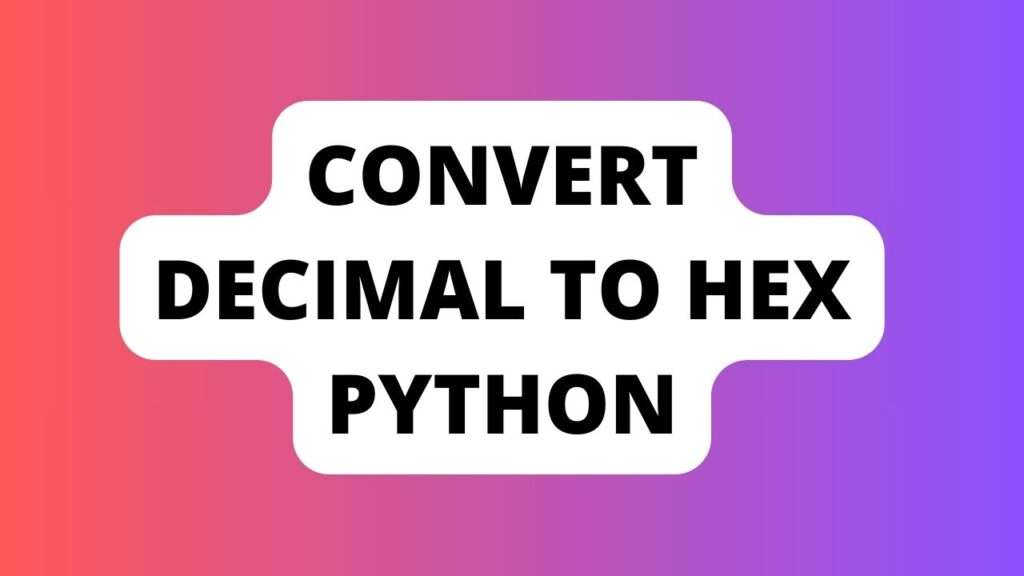Introduction
Convert Decimal to Hex Python Welcome to the world of Python programming! Understanding number systems like decimal and hexadecimal is fundamental. In this article, we’ll delve into the process of converting decimal numbers to hexadecimal specifically using Python.
What is Hexadecimal? Hexadecimal, base-16, uses digits 0-9 and letters A-F to represent values.
Importance of Converting Decimal to Hex in Python
Efficiency in Programming: Converting allows smoother operations in programming tasks.
Enhanced Readability in Code: Hexadecimal representations make code more comprehensible.
Methods for Decimal to Hex Conversion
Understanding the Decimal System: The sequential placement of digits and its significance.
Understanding the Hexadecimal System: The structure where each digit represents powers of 16.
Python Libraries for Conversion
Exploring ‘hex()’ Function: A built-in function simplifying conversion.
Implementation of ‘format()’ Function: Offering flexibility in formatting output.
Real-life Applications
Graphic Design Software: Color codes often use hexadecimal values.
Cryptography and Security Systems: Hexadecimal plays a vital role in encryption.
Common Errors & Solutions
Overflow and Underflow Issues: Handling scenarios beyond the data type’s capacity.
Incorrect Syntax Errors: Resolving issues related to code structure.
Convert Decimal to Hex Python
A comprehensive guide empowering you to seamlessly switch between number systems in Python.
Best Practices for Conversion
Error Handling Strategies: Addressing potential issues for seamless execution.
Code Optimization Techniques: Enhancing efficiency and performance.

What is Decimal?
Decimal, the base-10 number system, is what we use daily. It comprises digits from 0 to 9, and each digit’s position represents a power of 10. For instance, in the number 357, the 7 is in the units place, representing 7×1007×100, the 5 is in the tens place, representing 5×1015×101, and the 3 is in the hundreds place, representing 3×1023×102.
What is Decimal? Decimal, the base-10 system, uses digits 0-9 to represent numbers.
What is Hexadecimal?
Hexadecimal, base-16, uses digits from 0 to 9 and letters from A to F to represent values. It’s widely used in computing due to its concise representation of binary data. In hex, each digit corresponds to a four-bit binary sequence, simplifying operations on binary-coded values.
Benefits of Conversion
Easy Implementation
Converting decimal to hex in Python is straightforward, enabling seamless integration into coding tasks without complex algorithms.
Use Cases
Hexadecimal proves valuable in cryptography, memory addressing, and color representation in graphic design and web development.
Python Methods
Method 1: Using the hex() Function
The hex() function in Python converts decimal to its corresponding hexadecimal string. It takes a single argument, the decimal number, and returns the equivalent hex value.
Method 2: Custom Conversion Algorithm
Creating a custom function involves dividing the decimal number successively by 16 and noting the remainders until reaching zero, then translating remainders to hex digits.
Understanding Python Basics
Python Data Types
Python supports various data types, including integers, which allow manipulation of decimal and hexadecimal numbers seamlessly.
Number Systems in Python
Python provides flexibility in handling number systems, allowing developers to convert between different bases effortlessly.
Converting Decimal to Hex
Converting Method 2: Custom Algorithm
Implementing a custom function in Python involves iterative division by 16, considering remainders, and assembling the hex value backward.
Application in Programming
Graphic Representation
Hexadecimal’s use in representing colors simplifies defining colors in graphic design, web development, and image processing.
Algorithms
In algorithms and data structures, hexadecimal often aids in bit manipulation and efficient storage representations.
FAQs
- How to convert in Python? The
hex()function or a custom algorithm effectively converts decimal to hex. - Why use hex in programming? Hex simplifies binary data representation, enabling efficient manipulation and concise storage.
Conclusion
Converting decimal to hex in Python is a valuable skill. Python’s simplicity and versatility make this conversion effortless, empowering developers in various domains.
